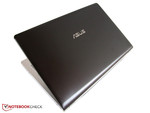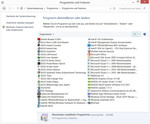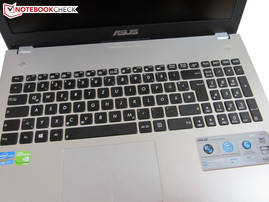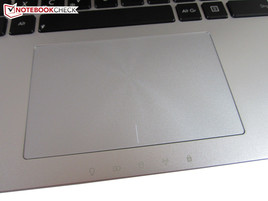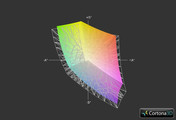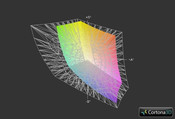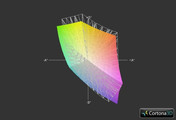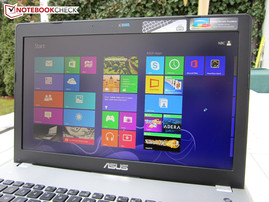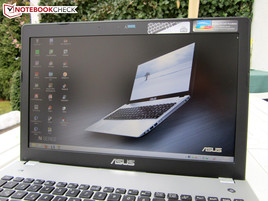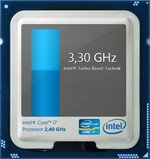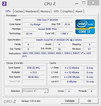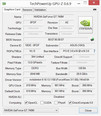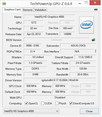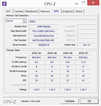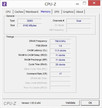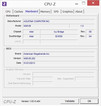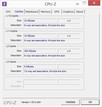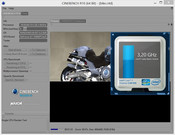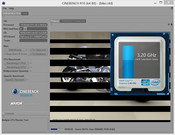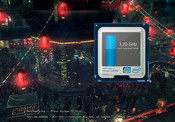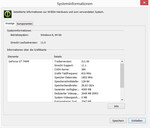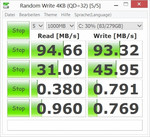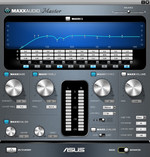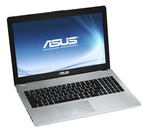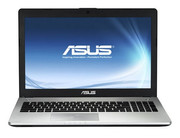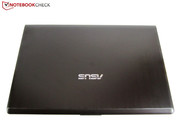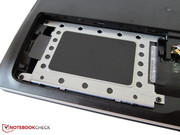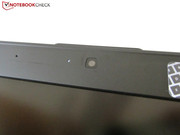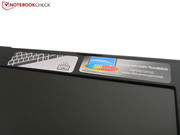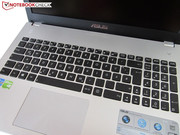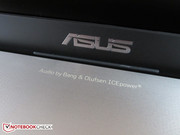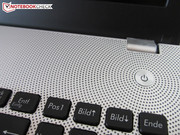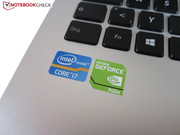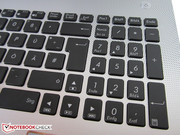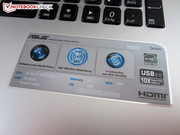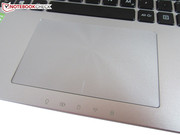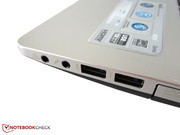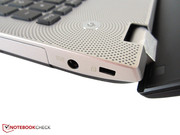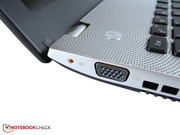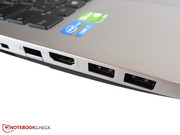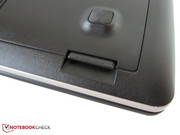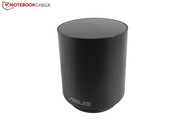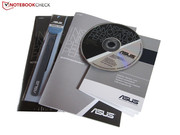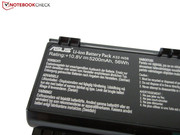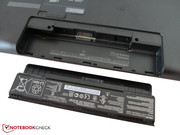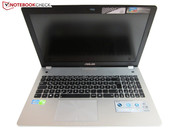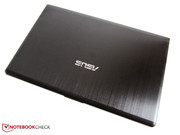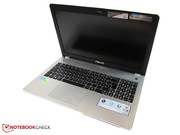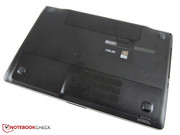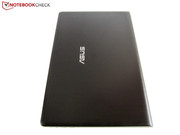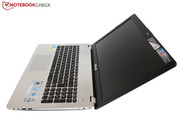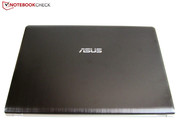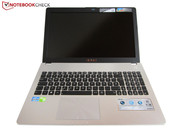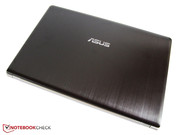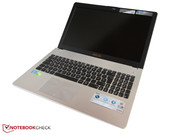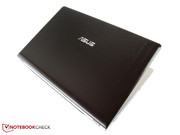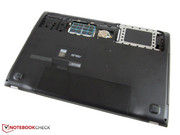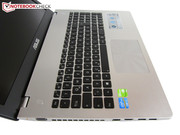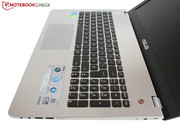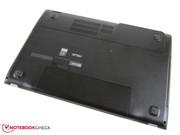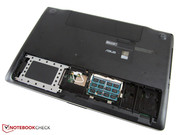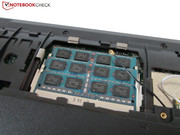Review Asus N56VB-S4050H Notebook
For the original German review, see here.
Asus' N56VB was already available in several configurations shortly after its launch. Depending on the model, the processor is either the dual-core i5-3230M (2.6-3.2 GHz) or the quad-core i7-3630QM (2.4-3.4 GHz). The CPU is accompanied by four to a maximum of eight GB DDR3 RAM (1600 MHz) and a 500, 750 or 1000 GB HDD (5400 rpm).
The GeForce GT 740M (2048 MB DDR3 VRAM) mentioned in the intro takes care of demanding graphic calculations. The different models show similarity in other things. The matte screens have a resolution of 1920x1080 pixels and optical data carriers can be rendered via a DVD burner. It is too bad that Asus does not use a Blu-ray drive despite the Full HD screen.
The operating system does not reveal any surprises. Windows 8 64-bit is the current standard whether or not the user likes Microsoft's new OS. The N56VB's price ranges from 800 to 1000 Euros (~$1054 to $1318, status: April 2013).
| Model | S4038H | S4024H | S4039H | S4040H | S4041H | S4042H | S4050H |
|---|---|---|---|---|---|---|---|
| Processor | Core i5-3230M | Core i5-3230M | Core i5-3230M | Core i5-3230M | Core i7-3630QM | Core i7-3630QM | Core i7-3630QM |
| Graphics card | GeForce GT 740M | GeForce GT 740M | GeForce GT 740M | GeForce GT 740M | GeForce GT 740M | GeForce GT 740M | GeForce GT 740M |
| Working memory | 4 GB DDR3 | 4 GB DDR3 | 8 GB DDR3 | 8 GB DDR3 | 8 GB DDR3 | 8 GB DDR3 | 8 GB DDR3 |
| Hard drive | 500 GB HDD | 750 GB HDD | 750 GB HDD | 1.000 GB HDD | 750 GB HDD | 1.000 GB HDD | 750 GB HDD |
| Optical drive | DVD burner | DVD burner | DVD burner | DVD burner | DVD burner | DVD burner | DVD burner |
| Display | Full HD matte | Full HD matte | Full HD matte | Full HD matte | Full HD matte | Full HD matte | Full HD matte |
| Operating system | Windows 8 64 Bit | Windows 8 64 Bit | Windows 8 64 Bit | Windows 8 64 Bit | Windows 8 64 Bit | Windows 8 64 Bit | Windows 8 64 Bit |
| Price (13/04/09) | EUR 800 | EUR 830 | EUR 880 | EUR 930 | EUR 950 | EUR 1000 | EUR 950 |
Case
The 15-inch device's exterior resembles the models N56VZ (GeForce GT 650M) and N56VM (GeForce GT 630M) that we tested about a year ago. The multimedia laptop looks rather ordinary in a closed state. The casing's plastic bottom and brushed aluminum lid feature a dark color.
As soon as the device is opened, the black components clearly vanish in the background. The keyboard's elegant silver-colored metal rim scores just like the laptop's sides. The display's gray bezel and the black keyboard ensure nice highlights. We also discovered a stylish, wave-pattern grille in the speakers' area. In our opinion, the optical design is a success.
There is a bit of room for improvement in terms of casing stability. Although the base unit only yields under stronger pressure, the maintenance cover and lid could be more rigid. Nevertheless, the N56VB fares quite well compared to other all-round laptops. The build quality generally does not leave much to be desired. The material transitions on our test device were quite accurate. There is not much reproach for the hinges either. Opening with one hand is possible although the base unit tends to lift. The lid deals reasonably well with surface vibrations.
The N56VB is neither exceptionally heavy nor light with a weight of approximately 2.7 kilograms (~6 pounds) and thus is quite suitable for carrying around. The same is true for its size of 380 x 255 x 35 millimeters (~15.0 x 10.0 x 1.4 inches, width x depth x height), which is common for the 15-inch range (e.g. Acer's Aspire V3-571G).
Connectivity
Interfaces
The interfaces have been completely adopted from the old models. On the right, we find one headphone and one microphone audio jack, two USB 3.0 ports, the power socket and a Kensington lock. Two more USB 3.0 ports, a VGA and HDMI port, an RJ-45 Gigabit LAN port and a socket for the included subwoofer are on the left.
Aside from the somewhat unfavorable interface positioning (cords could get in the way when using an external mouse), the unwieldy RJ-45 port particularly annoyed us in practical use. We do not really understand why Asus designed the network port as a foldout mechanism. There would have actually been enough room for a standard port. We are not dealing with a slim ultrabook in this case. Regardless of that, Asus has also installed a card reader for MMC, SD, MS, and MS Pro on the front.
Wireless Communication
Naturally, wireless Internet connections are also possible with the N56VB. Although the manufacturer installs a much known and very popular product from Intel, namely the Centrino Wireless-N 2230, its range proved to be rather modest. The connection quality dropped to just one or two bars at a distance of only a few meters and only three or four of the five Wi-Fi bars were partly displayed even directly beside the router. We have seen better results here. Intel's module supports 802.11 b/g/n Wi-Fi standards (300 Mbit/s maximum) and Bluetooth 4.0.
Update 07/29/13: One of the readers discovered a disconnected cable in our pictures. That should explain the bad range.
Maintenance
As typical for laptops, the maintenance possibilities are somewhat limited. Like most competitors, the base plate, secured with screws, only gives access to the hard drive slot for 2.5-inch HDDs or SSDs and both DDR3 RAM banks. Inexperienced users can also replace or upgrade components. The cooling system, processor and graphics card regrettably cannot be accessed directly.
Software
Instead of treating the user to a decent recovery system, Asus prefers to install many other tools on the laptop. For example, we found a trial version of Microsoft's Office 365 and McAfee's Internet Security. Many of the additional programs come directly from Asus. The system can be updated via Live Update and image rendering can be modified via Splendid Technology. AsusDVD is a media player from CyberLink.
Accessories
The accessories are impressive. A driver & tool DVD is found inside the box alongside cable ties and several information brochures (warranty card, manuals, etc.). The strong 56 Wh lithium-ion battery is known from the predecessors. Asus however has now designed the 120 Watt power supply unit a bit slimmer, now only 160 x 76 x 25 millimeters/~6.3 x 3.0 x 1.0 inches). The biggest highlight is the cylindrical and lightweight 262 gram (~0.58 pound) subwoofer (see right picture column). The accessories would have been even nicer with a recovery DVD.
Warranty
Asus includes a two-year, international hardware warranty on the device. The battery is only covered for one year.
Input Devices
Keyboard
The chiclet keyboard made a good impression. The user will quickly become accustomed to it owing to the matte surface, decent key size (main keys: 1.5 cm, number pad: 1.2 cm) and the prominent gaps.
The key lettering and distribution of the special functions do not give much reason for complaint. For example, the volume and screen brightness can be adjusted in the F row. Except for the combined DEL/INS key, the layout makes a good impression.
The typing feel should satisfy most users. The pressure point and stroke are decent although the feedback could be a bit crisper according to the author. Those who work at night will be particularly happy about the multistage light, which is however not quite homogeneous as typical for Asus.
Touchpad
The mouse replacement did not awe us despite its generous size of 114 x 71 millimeters (~4.5 x 2.8 inches). On the one hand, the touchpad makes a clattery impression and on the other, it sometimes lacks accuracy. Some contending products are more direct and less spongy.
That however does not mean that the touchpad exhibits a poor performance. We would list its decent multi-touch capability as well as the clearly arranged and well-structured software on the pro side. The supported gestures are descriptively explained in a video. Mouse detection can also be enabled so that the touchpad is deactivated when an external mouse is connected.
We did not take a liking to the two buttons. It is often hard to tell when and where an input has been detected since the touchpad is not separated. The main field also emits a click noise depending on the amount of pressure applied. The fairly sleek and thus pleasant surface only compensates this flaw to an extent.
Display
The manufacturer does not make any compromises with the screen. Although the N56VB cannot serve with an IPS screen, a high-quality TN screen is a rare thing. Thus, the LG Philips LP156WF1 excites with an outstanding brightness. While most laptop screens range between 200 and 300 cd/m², the N56VB achieves an average of 360 cd/m², which is an excellent rate. The 15-incher shines so intensely that the brightness should even be reduced a bit indoors.
| |||||||||||||||||||||||||
Brightness Distribution: 84 %
Center on Battery: 398 cd/m²
Contrast: 765:1 (Black: 0.52 cd/m²)60.7% AdobeRGB 1998 (Argyll 2.2.0 3D)
87.1% sRGB (Argyll 2.2.0 3D)
58.8% Display P3 (Argyll 2.2.0 3D)
A black value of 0.5 cd/m² is however only enough for the midfield. Darker screen content sometimes tends to look light gray. Otherwise, the N56VB scores quite well. An ordinary, run-of-the-mill screen cannot compete with a contrast of nearly 760:1. The color space coverage of the LG Philips LP156WF1 is also viable. The picture looks overall vivid and natural.
The N56VB is perfect for work owing to the lavish resolution. Two adjacently opened windows, for example MS Office and a browser, are no problem in contrast to models with 1600x900 or 1366x768 pixels. A disadvantage of the high pixel count is the enormous computing effort. As our gaming benchmarks shows, 1920x1080 pixels are not ideal for the GeForce GT 740.
In return, "ideal" fits to outdoor suitability. Since the brightness remains stable in battery mode and Asus uses a matte surface, the content's legibility is great even on brighter days. The above average viewing angles add to that. Unlike cheaper models, the screen does not have to be constantly (re-) adjusted.
Performance
Processor
The more expensive models in the N56VB range are powered by a quad-core from Intel's current Ivy Bridge generation (22 nm). The Core i7-3630QM can increase its clock up to 3.4 GHz via Turbo Boost.
Another feature is Hyperthreading technology that supplies every physical core with a virtual counterpart. Since 4 + 4 equals 8, eight parallel threads are thus possible. The high performance of the Core i7-3630QM is not least due to the 1.4 billion transistors and the six MB L3 cache. For comparison, the 2.6 - 3.2 GHz Core i5-3230M "only" has a three MB L3 cache. A major advantage of the dual-core CPU is its low power consumption of 35 rather than 45 Watts (TDP).
However, regardless of the processor, Nvidia's graphics switching Optimus enables the N56VB to switch between the integrated and dedicated GPU. According to the requirement, either the HD Graphics 4000 or the GeForce GT 740M is enabled. Optimus works virtually flawlessly. We can verify that the technology is very reliable. Single programs can also be manually assigned to a specific graphics card via Nvidia's system control (right click on desktop). A global setting is also available.
Turbo Boost
The CPU clock works properly under normal circumstances. Regardless whether only one or several cores are loaded, the Core i7-3630QM settles to around 3.2 GHz, which is close to the Turbo's maximum. The processor usually clocks over the default rate of 2.4 GHz even when the GeForce GT 740M is enabled (see screenshot 3 for comparison). Temporary processor throttling only occurred in extreme cases since it is an enormous strain for the system. Single cores briefly dropped to 1.2 GHz in the Unigine Heaven benchmark.
CPU Performance
Only a few laptop CPUs can compete with the performance of the Core i7-3630QM. With 21756 points, the Ivy Bridge model calculates almost twice as fast as Intel's Core i5-3230M in Cinebench R10 multi-core rendering (11108 points @ Acer Aspire V3-571G). The difference was much lower in the single-core test. 5770 to 5127 points equal a plus of only 13%.
Users with a tight budget can confidently take the entry-level model of the N56VB. The benefits of a quad-core are only rarely noticed in practical use. Most 3D applications are GPU-limited.
| Cinebench R11.5 | |
| CPU Single 64Bit (sort by value) | |
| Core i7-3630QM | |
| Core i5-3230M | |
| CPU Multi 64Bit (sort by value) | |
| Core i7-3630QM | |
| Core i5-3230M | |
Graphics Card
Nvidia again causes a lot of confusion with its new GeForce 700M series. A few models that are still based on the GF117 chip (710M & GT 720M) from the prior Fermi generation exist beside modified Kepler models with a GK107 and GK208 chip (GT 730M to GT 750M).
To add to the confusion, single graphics cards are also offered in different versions. The GeForce GT 740M is the perfect example for this. Depending on the laptop, either a DDR3 or a GDDR5 with a 128 or 64-bit memory interface takes care of all pending calculations, including deviating clock rates. Asus opted for the "conventional" alternative for the N56VB. Its big 2048 MB and fast 1800 MHz DDR3 memory features a 128-bit bus.
One of the most important features of the 700 range is the revised Turbo mode (GPU Boost 2.0). It now also includes the temperature as well as power consumption. According to Nvidia, the performance is to increase by up to 15%. In the case of Asus' N56VB, the default clock of 810 MHz is stably increased to 895 MHz during load.
Like the Kepler models, the GeForce GT 740M is manufactured in state-of-the-art 28 nm process. The graphics card is positioned in the midrange with 384 Shader units. An official Nvidia driver was not yet available at the time of this review. The slightly older ForceWare 311.00 was installed on our device.
Graphics Performance
The graphics benchmarks confirm that the GT 740M provides good performance. We would like to focus on two DirectX 11 tests in this text. The 28 nm product settles almost 80% above the popular GeForce GT 630M (1126 points @ Asus N76VM) and roughly 20% above the GeForce GT 640M (1731 points @ Acer Aspire M3-581TG) with a GPU score of 2044 points in 3DMark 11. The GT 650M Kepler model has a slight lead (2113 points @ Medion Akoya P6815).
The gaps shift a bit in the Unigine Heaven 2.1 benchmark, which we perform with 1280x1024 pixels, high details and default tessellation. 23.4 fps are on a par with the GT 640M. While the GT 650M achieves a 25% higher score (~29 fps), the GT 630M lags behind by approximately 30% (~16 fps).
| Unigine Heaven 3.0 - 1920x1080 DX 11, Normal Tessellation, High Shaders AA:Off AF:Off (sort by value) | |
| GeForce GT 740M / Core i7-3630QM | |
| GeForce GT 630M / Core i7-2630QM | |
| Radeon HD 8750M / Core i5-3210M | |
| GeForce GT 650M / Core i5-3360M | |
| 3DMark - 1920x1080 Fire Strike Graphics (sort by value) | |
| GeForce GT 740M / Core i7-3630QM | |
| GeForce GT 630M / Core i7-2630QM | |
| GeForce GT 640M / Core i7-2637M | |
| Radeon HD 8750M / Core i5-3210M | |
| GeForce GT 650M / Core i5-3360M | |
| 3DMark 06 Standard Score | 12832 points | |
| 3DMark Vantage P Result | 8605 points | |
| 3DMark 11 Performance | 2238 points | |
| 3DMark Ice Storm Standard Score | 67664 points | |
| 3DMark Cloud Gate Standard Score | 8226 points | |
| 3DMark Fire Strike Score | 1269 points | |
Help | ||
Storage Devices
The 750 GB HDD comes from Western Digital and is dubbed Scorpio Blue WD7500BPVT-80HXZT3. The slim, 9.5 millimeter (0.37 inch), 5400 rpm model supplied decent rates in special HDD tests such as HD Tune and CrystalDiskMark. The latter tool recorded a sequential read and write rate of over 90 MB/s.
Subjectively, the HDD does not seem especially fast or sluggish. However, its performance is of course remote from that of a solid-state drive. An SSD would not only have an impact on the speed (boot time, load times, transfer rates, etc.) but also on the noise. Impatient users who have the necessary means should consider upgrading. HDDs soon find their limits in heavy multitasking.
System Performance
Asus' N56VB was quite inconspicuous in the system benchmarks. Almost 10000 points in PCMark Vantage are more or less the maximum that can be retrieved with a conventional HDD. Samsung's 700G7C (9795 points), Asus' A95VM (9829 points) and MSI's GT60 (10103 points) achieved similar scores.
| PCMark Vantage Result | 9861 points | |
| PCMark 7 Score | 3065 points | |
Help | ||
Gaming Performance
The gaming performance exhibited by the GeForce GT 740M was quite mixed. Undemanding games like Mass Effect 3, Counter Strike: Global Offensive, FIFA 13 and Dishonored were rendered smoothly even in maximum settings including anti-aliasing.
However, graphics-hungry titles such as Far Cry 3, Crysis 3 or Hitman: Absolution stuttered a great deal in higher settings. As a result, the resolution sometimes had to be reduced, which is known to be at the expense of sharpness.
Casual gamers who can live with compromises in graphics quality and speed will however get a system that is suitable for up-to-date games with restrictions. We were nevertheless a bit disappointed in the GT 740M since it was overall only enough for the level of a GT 640M. It should be possible to expect bigger performance leaps from a new model range.
Incidentally, the main competitor AMD uses a similar, confusing naming strategy. Old architectures are often masked as an allegedly new generation.
| Borderlands 2 - 1920x1080 (Ultra) High / On (PhysX low) AA:FX AF:8x (sort by value) | |
| GeForce GT 740M / Core i7-3630QM | |
| GeForce GT 630M / Core i7-2630QM | |
| GeForce GT 640M / Core i7-2637M | |
| GeForce GT 650M / Core i5-3360M | |
| low | med. | high | ultra | |
| Alan Wake (2012) | 44.2 | 25.3 | 12.8 | |
| Mass Effect 3 (2012) | 60.1 | 53.9 | 35.4 | |
| Dirt Showdown (2012) | 101.6 | 80.3 | 50 | 17.9 |
| Max Payne 3 (2012) | 46.5 | 39.8 | ||
| Sleeping Dogs (2012) | 91.7 | 68.3 | 27.6 | 6.8 |
| Counter-Strike: GO (2012) | 226.8 | 169.6 | 114.1 | 55.7 |
| Guild Wars 2 (2012) | 94 | 36.2 | 12.3 | |
| F1 2012 (2012) | 146 | 103 | 80 | 29 |
| Borderlands 2 (2012) | 77.3 | 57.6 | 41.4 | 26.5 |
| Fifa 13 (2012) | 437.6 | 215.4 | 187.2 | 123.5 |
| Dishonored (2012) | 97.7 | 78.9 | 70.2 | 41.5 |
| Call of Duty: Black Ops 2 (2012) | 107 | 80.7 | 46.7 | 28.8 |
| Hitman: Absolution (2012) | 51.8 | 35.1 | 17.2 | 7.3 |
| Assassin´s Creed III (2012) | 49.4 | 42.1 | 12 | |
| Far Cry 3 (2012) | 67.9 | 47.4 | 23.7 | 7.6 |
| Crysis 3 (2013) | 47.9 | 28.3 | 19.8 | 7.4 |
| Tomb Raider (2013) | 111.4 | 57.9 | 35.3 | 14 |
| StarCraft II: Heart of the Swarm (2013) | 227.4 | 86.8 | 51.9 | 19 |
| BioShock Infinite (2013) | 90.4 | 49.9 | 41.9 | 12 |
Emissions
System Noise
Most users will unlikely find the system noise distracting. Although the laptop was always audible in idle, we never found the subtle hard drive noise ranging from 30 to 33 dB(A) annoying. Seeing that the fan either vanishes into the background or remains completely silent during more basic tasks, sensitive users will find investing in an SSD worthwhile.
The DVD burner exhibits good behavior if the user can ignore its short speed increase. It was quite loud when accessing data. We recorded an average of 37 dB(A) while playing a movie using the optical drive, which is a middling rate. The fan was first noticed in 3D and gaming use. Around 38 dB(A) in 3DMark 06's first sequence are reasonable in our opinion. The fact that 40 dB(A) was not surpassed even in the stress test, induced using FurMark + Prime95, is good.
Noise Level
| Idle |
| 29.8 / 30.9 / 32.8 dB(A) |
| DVD |
| 37 / dB(A) |
| Load |
| 38.2 / 39.2 dB(A) |
 | ||
30 dB silent 40 dB(A) audible 50 dB(A) loud |
||
min: | ||
Temperature
The temperature development will unlikely bother anyone either. The temperature is agreeably cool at idle with an average temperature of 26 °C (78.8 °F). Our thermometer recorded an average of 33 °C (91.4 °F) on the laptop even during full load, which is not exceedingly warm.
In return, the components make a mixed impression. Good: A CPU and GPU temperature of 70-80 °C (158-176 °F) is absolutely acceptable. Bad: The Core i7-3630QM throttles to 1.2 GHz after a short while.
(+) The maximum temperature on the upper side is 36.3 °C / 97 F, compared to the average of 36.9 °C / 98 F, ranging from 21.1 to 71 °C for the class Multimedia.
(±) The bottom heats up to a maximum of 41.5 °C / 107 F, compared to the average of 39.1 °C / 102 F
(+) In idle usage, the average temperature for the upper side is 26 °C / 79 F, compared to the device average of 31.2 °C / 88 F.
(+) The palmrests and touchpad are reaching skin temperature as a maximum (34 °C / 93.2 F) and are therefore not hot.
(-) The average temperature of the palmrest area of similar devices was 28.8 °C / 83.8 F (-5.2 °C / -9.4 F).
Speakers
SonicMaster, Bang & Olufsen ICEpower, Waves MaxxAudio. Asus uses many keywords for promoting the speakers. This is justified as we ascertained in the test.
Regardless whether the external subwoofer was connected, the sound proved to be surprisingly clear, accurate and balanced for a laptop. All media was rendered adequately. Naturally, the best sound is derived with the subwoofer because the bass seems richer. It is also possible to fill bigger rooms with sound adequately owing to the N56VB's high maximum volume.
The sound can be perfectly customized via the preinstalled software. In addition to various scenarios, e.g. music, movies, gaming, it provides sound enhancements and an equalizer.
Energy Management
Power Consumption
The power consumption is higher than in other multimedia laptops due to the quad-core CPU and bright screen. With 11-25 Watts, the idle power consumption is clearly higher than the recently reviewed 15-inch Samsung 510RE-S01DE (7-14 Watts), which sports a dual-core processor and equally swift AMD Radeon HD 8750M.
The N56VB follows devices using Nvidia's GeForce GT 640M or GT 650M during load. For example, 76 Watts is roughly the average of Acer's Aspire V3-571G-53214G50Maii (71 Watts) and Asus' N56VZ-S4044V (80 Watts) in 3DMark 06.
| Off / Standby | |
| Idle | |
| Load |
|
Battery Runtime
The battery runtime is within the average range for multimedia devices. The 15-incher lasted between one and five hours depending on the screen's brightness and system load. We recorded almost three to four hours from the N56VB during normal use (office, Internet, video files, etc.). We would appreciate a somewhat stronger battery in the successor.
Verdict
There is hardly a better multimedia laptop than Asus' N56VB for less than 1000 Euros (~$1318) at the moment. The 15-inch, versatile device only exhibits a few shortcomings that are mostly not serious.
Although the port distribution is partly adverse, the casing convinces to the largest extent. In contrast to glossy laptops, the matte, metal surfaces are quite insensitive in terms of fingerprints and dust. The backlit keyboard is also a plus point.
Owing to graphics switching and modern hardware, the temperature and noise emissions are no reason for concern either. However, it is too bad that the GeForce GT 740M only insignificantly stands out from its predecessor. Our benchmarks show that the GT 640M successor places itself between the GT 630M (Asus N56VM) and GT 650M (Asus N56VZ).
On the other hand, we quite appreciate that Asus not only pays attention to image but also sound quality. The competition can take an example from the 2.1 system. Although it adds weight, the included subwoofer is a nice idea. We can only list the omitted recovery DVD and poor Wi-Fi range as drawbacks for the all-round laptop. The manufacturer also wastes potential in battery runtime and the touchpad.
It is nevertheless enough for a clear purchase recommendation.


 Deutsch
Deutsch English
English Español
Español Français
Français Italiano
Italiano Nederlands
Nederlands Polski
Polski Português
Português Русский
Русский Türkçe
Türkçe Svenska
Svenska Chinese
Chinese Magyar
Magyar
